The Box and Goodies -
Well, I guess I will just come out and say it. Gigabyte, please get rid of the reflective surface on your motherboard boxes. It is not needed and it really makes them look cheap. There truly is no need for that extra flash on the product box. There is plenty to catch the eye on them already. Just looking at the front of the box there are no less than five major selling points and two secondary selling points. When you lead with items like SATA 3.0, 4-Way Crossfire, USB 3.0, Auto Unlock (to unlock those Extra CPU Cores) and GB’s new ON/Off Charge there really is no need for the extra flashy surface.
 |
 |
Under the front side of the box we find more selling points hidden on the inside of flap. Many of these are repeats from the front (with a little more information attached), but there are a couple of new ones here for you as well. One of the more intriguing ones (for us and most enthusiasts) is the Precision OV; with precision OV you get a finer stepping on the voltage adjustment as well as real-time adjustment. We will be taking a closer look at this later in our coverage. Once you are finished reading all of this wonderful information you will get a glimpse of the 890FXA-UD7. Alright, you probably saw that first and then, maybe, you read the selling points on the inside of the front flap.
 |
 |
The back of the box takes you in for an even closer look at what is going on with the 890FXA-UD7. GB has included a board shot with some detailed bullet points on major features. They also go into an explanation of the 2 ounce Copper PCB and its advantages to you.
Inside the box is a decent selection of goodies for use. GB has included their favorite e-SATA bracket (complete with Molex connection) for you to attach non-enclosed drives. There are also two Crossfire Bridges for that Quad Crossfire setup you have been dreaming about.
The Layout -
The layout of any motherboard is important. Even simple mistakes in component placement or the signal traces can cause major issued in performance and stability. With the ATX form factor we find that this is even more true; the devices we drop onto them demand more and cleaner power while the signal speeds push faster and faster.
Just looking at the 890FXA-UD7 you know that it is a busy board. There are PCIe slots all over the place. There are a total of six x16 mechanical on the board (although not all are going to be x16 electrical) along with a legacy PATA and Floppy connector. The extra PCIe slots have made Gigabyte extend this board. Instead of the normal ATX form factor it now qualifies for E-ATX status. This means you won’t be dropping this into just any case.
 |
 |
Looking at the upper half of the board we do find a couple of odd layout choices. GB has placed the power and reset buttons behind the 24-pin power connector and very close to the Floppy and PATA ports. This really made them hard to reach on the test bench, but not impossible. The RAM slots are also rather tightly spaced making some high-performance RAM (notably G.Skill with their thick heatsinks) hard to seat side-by-side. The AM3 socket is (In my opinion) very outdated; as it stands it takes up an enormous amount of space on the board that could be put to better use. Of course the upside is that you can use the same heatsink you used with the AM2 and AM2+ sockets. As with almost all ATX motherboards the 8-pin 12V Aux power connector is in an awkward spot. It is fairly easy to get in, but a huge pain to get out. We also can see the 8+2 phase power setup. Of course this sounds rather small compared to the 24 and 32 phase monster boards we see with the X58 chipset. Still we have to wonder if this could come back to haunt us when we push the board. Without enough clean and stable power things can go south pretty fast. We will have to find that out later though.
Moving down the board we find a nice bit of extra cooling. This is pretty much the stock fare for the UD7 series boards but it is nice to take a look at. The interesting thing about the cooling on the 890FXA is that the chipset is not what needs the most cooling. While it does generate some heat, where you really want this cooling for is the power regulation. Some of the Phenom II CPUs can be very power hungry. If you are planning to overclock GB gives you two options for cooling. You can put on an extended heatsink (for inside a case predominantly) or you can leave the small chipset water block on and connect it to your water cooling system.
 |
 |
 |
Moving down to the lower half of the board we see those six PCIe x16 mechanical slots. Now looking at the shot here you will see that only two slots have a full x16 electrical connection. These areslots 1 and 5; slots 2 and 4 are x4 and slots 3 and 6 are x8. If you are looking at setting up quad crossfire then you will drop cards in slots 1, 3, 5, 6; this will give you x8 across all cards. The other side of the board shows us the six SATA ports and the dual SATA 3.0 ports.
 |
 |
The ports on the 890FXA-UD7 are fairly standard fare; you get four normal USB ports, two that are powered (right above a pair of eSATA ports) and two Firewire ports, one normal and the other smaller. You also get two GBe lan ports care of Realtek and a pair of USB 3.0 ports. Like I said pretty normal fare.
Features -
In the current market motherboard (and indeed almost all component) performance is very close. The days of a large performance advantage between boards using the same chipset are long gone. That is unless someone makes a HUGE mistake (like runs traces completely wrong). Now, the thing that differentiates different products is the features. These are things like power management, extra slots, better audio CODECs etc. It is these items that R&D teams work so hard to drop into what are really identical pieces of hardware at their most basic level.
Gigabyte is like many companies, they are going to list everything as a feature. However, as we mentioned above not all features are real. Some are great and some are like the floor mats in your car listed as a feature, but you know you are going to get them with every car you look at.
Excellent
Auto Unlock
SATA 3.0
USB 3.0
Dual GBe LAN
Precision OV
Quad Crossfire
These items are excellent reasons to pick up the 89FXA-UD7. They are things that differentiate the product from others in its class and also from other 890FX boards from GB.
In the middle (sort of good)
ON/OFF Charge
Smart Recovery
Xpress BIOS Rescue
Dual BIOS
Silent Pipe II
USB/eSATA Combo
EasyTune 6
Here we have a feature set that adds value but are usually not going to be deal breakers.
@BIOS
This list is, well it just is. Almost all of this you would expect on a high-end motherboard. If these things were missing (whatever they are called) you would probably not be picking that product up.
BIOS -
BIOS is an acronym that stands for Basic Input/Output System. It is meant to control your product at a very low level. As of right now there are three regularly used BIOS formats (there are actually more than that but there are three common ones). These are the AMI (American Megatrends Incorporated), Award, and Phoenix.
As we move into the BIOS we find an Award layout with some very obvious tweaks from GB. If you are at all familiar with Gigabyte and their products you will know that you want to hit up the M.I.T (MB Intelligent Tweaker) for most of your overclocking and performance options.
It is in the MIT section that you can find almost all of the settings you will need to overclock the 890FXA-UD7. This includes the CPU ratio “FSB” PCIe clock, HT width and frequency, the memory multiplier and of course the voltage options. There is also a sub menu that controls the timings and other advanced settings for the system memory. A few tweaks here can yield a lot of performance with an AMD CPU, especially if you can cut down the latency on the memory as that is generally what holds most CPUs with an integrated memory controller. With AMD CPUs there is also a lack of fast caching instructions to overcome this limitation.
 |
 |
 |
Under the advanced BIOS features page we find a few more tweaks but these are much more general in nature. For example, you can sometimes squeeze a few more MHz out of a CPU with Cool and Quiet off or with Virtualization disabled, but for the most part these have little effect on overclocking or daily performance (unless you are running XP pre SP2).
 |
 |
The integrated peripherals page is important for both overclocking and daily use. If you are looking to push the board you can disable extra components of the board to help maintain stability. If you are just setting up for daily usage you can adjust items here like SATA controller type, USB support, and disable the usually unneeded parallel and serial ports. PC Health lets you adjust items like the built in thermal controls, temperature warnings and smart FAN controls. A note about the Hardware Thermal Control; we found that leaving this enabled hindered our overclocking a bit as you will see below.
There are more places in the BIOS to tinker and tweak but these are the most common and the ones that will yield the biggest results.
Overclocking -
As we covered in the BIOS section to OC your 890FXZ-UD7 you will be hanging out in the MIT section. We did this and were disappointed to find out that we could not get our 1090T to push past 3.8GHz without the board clocking it down to less than 1GHz. We knew that something was not right. This CPU should be able to clock much higher than that even with its much lower T-Max Junction. So we began searching through the BIOS looking for something that was throttling the CPU back. We tried Cool and Quiet, we shut off the Core Boost feature, but none of that helped at all. Finally we hit up the PC Health Status pages to see if there was an issue with fan settings. That was when we found the Hardware Thermal Control; this little feature was the key to unlocking an additional 200MHz+ on the PII 1090T. We booted into windows at 4.2GHz without seeing the system throttle us back to 900MHz. Unfortunately it was not stable and with our limited time to tinker we were unable to get it stable before we finished up this article. We have a feeling that with a little more playing around we will find the setting(s) that will let us get past this obstacle. For our final stable test overclock we were able to push the Phenom II X6 1090T to 4.016GHz (251 x16), this is a high mark for this particular 1090T as previous to this we have only been able to hit around 3.98GHz.

Of course overclocking is a picky subject. I can buy to identical CPUs from the store and they will not always perform the same way under stress. This is the same with motherboards, RAM and GPUs. The 890FXA-UD7 does not do a bad job considering the CPU we chose, you might have much better luck with a lower clocked CPU or one with less cores. We have not tested the board with a dual, tri, or quad core so we cannot comment on that directly. However, our best guess would be that the 890FXA-UD7 can give you some very good overclocking potential. Again it is important to keep in mind that our results represent a specific hardware configuration. Yours may be similar but will rarely be identical.
Overclocking Tools
Besides items like Precision OV and Silent Pipe II Gigabyte gives you there EasyTune 6 software for simple Windows based overclocking. This tool is well thought out and has an intuitive design for easy use by beginners as well as experienced overclockers. Even the CPU page is simple and provides you with all of the information you need at a glance.
If you are going to use this tool to push the limits of your CPU then the Tuner tab is the place you want to head to. There are two modes of operation; well there are three really, but one is a simple “Easy Boost” option that will poll the CPU and give you a basic overclock. The software warns that this is only to be used with Black Edition CPUs though as it will change the multiplier as needed to give what the software feels is the best speed.
 |
 |
As you would expect under the advanced option for EasyTune6 you get quite a bit more flexibility for what you can do to your CPU. In addition to extra options for Frequency and Voltage you also have control over the Core Boost as we found this hindered our overclocking attempts we had it shut off during our testing runs. As this is an AMD chipset you also have some direct control over the GPU with EasyTune6. Oddly we found that this software incorrectly reported the fan speed on our reference HD5870. It showed up as 1,091% which is quite a feat for any small fan like that.
 |
 |
EasyTune also includes a basic hardware monitor tab. It can show you the voltages in use as well as some fan header settings and of course temperatures. 
Overall EasyTune6 is good software with a few minor bugs and issues that will most certainly be ironed out in future releases.
The Test System and Comments
Our test system is built on an open bench. This has two effects on testing. First it allows us to see everything and also to setup and disassemble the test rigs quickly. Second it means that we cannot gauge the potential air flow found in a normal case. The air is pretty stagnant; some may say this is a great neutral testing method and it can be. However, it does mean that the temperature reading taken off of the components are not accurate to what an average consumer would see. This means that your thermal performance will vary from what we see here.
The system build was pretty simple. There is really not much to setting up a system for use on a test bench. We had the usual issues with plugging in the 8-pin Aux power connector but that is nothing new. Earlier we mentioned the placement of the power and reset buttons on the board. This placement did turn out to be something of a pain. The thought of putting these two buttons on the leading edge of the upper half of the board is a good one, but placing them behind the 24-pin power connector was not. Reaching these buttons was not horrible, but it was awkward. Driver installation was easy and fast; we did not have any issues getting the extra software installed and within about 10 minutes everything was up and running.
Performance testing overview
Our testing is a little different than most. We combine both synthetic and real-world applications to simulate the types of performance common to the individual products. For motherboards this means that we run roughly six synthetic tests and two real-world. We will be expanding the real-world testing in the near future. But there is more to performance than just the raw numbers. As there are multiple components and sub-components on a motherboard there each item can have a distinct impact on the way the product will perform once you get it in your system. It is important to note not only the actual results but what they mean to you as a potential consumer. We will try to give this information to you. But we do not just cover the performance aspects that are measurable. We also talk about the components that might not have a direct benchmark. These are items like Audio Quality, ease of use and installation. *As a note the H55N shown in these graphs was using an Intel Core i7 875K and an HD 5970. I included it only as an afterthought; it was interesting to see the numbers in comparison especially the gaming numbers.
Section 1 Subsystems
Memory -
Memory performance is very important on a motherboard, especially when you have a CPU with multiple cores and threads. If you have slow memory your cores and threads can become starved for data to execute. To test memory performance we run both Sisoft’s SANDRA and Everest Ultimate. These two combine to not only give us accurate numbers but to validate each other. For testing at stock speeds the memory is hard set to 1333MHz while overclocking testing is done at the highest stable speed for the voltage of 1.65v this is due to the different memory dividers for each CPU. As such, the memory speeds will vary greatly. This means that the overclocked numbers are a little misleading and while they can show a trend are really only included to show if a board has a problem with memory performance at high clockspeeds.
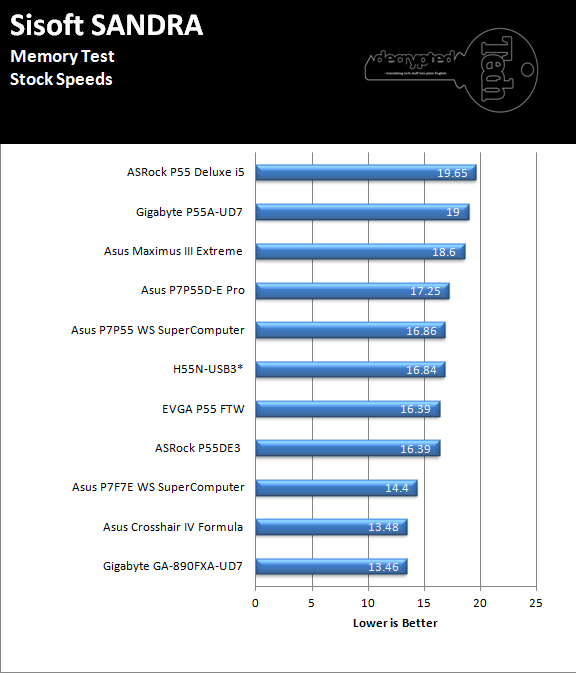 |
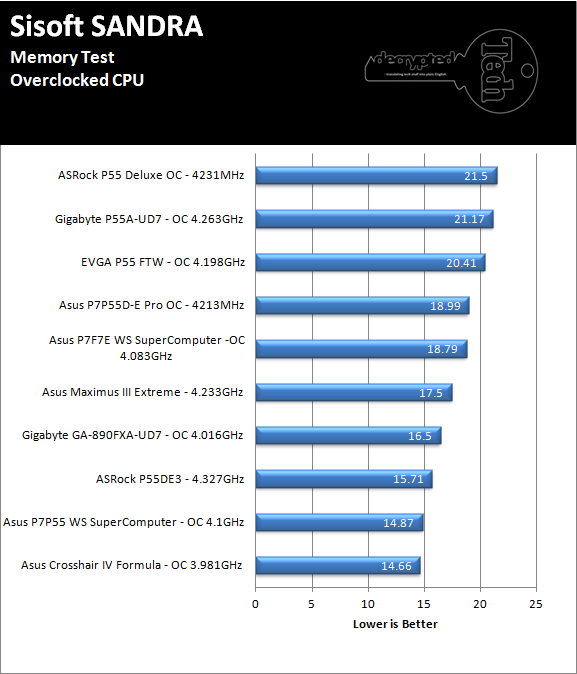 |
As we mentioned above AMD CPUs in particular have some memory speed issues. It revolves around an issue inherent with AMD’s IMC design. Going all the way back to the original Athlon CPU AMD has had performance issues with higher latency RAM. This issue became even more evident with the release of the AM2 and the reliance on higher speed, but lower latency DDR2. Now in the age of DDR3 we find the same problem. You can counter this by pushing the latency down often sacrificing actual memory clock speed. However none of that helps us with the current hardware we used.
 |
 |
Everest shows us again that AMD CPUs are not memory efficient. This is not a fault of Gigabyte, but one that systemic the chipset and CPU used. If there is not something to counter balance this performance hit then we might see poor scores in the rest of our tests.
Drive performance -
Drive performance is also one of the major subsystems that goes to make up the performance of a motherboard. For our testing we use Sandra and Everest again. We only test with single drives for each type of controller present on the motherboard (unless it is a professional product where we will use RIAD 5 and/or 10). We have also begun using a Seagate PS-110 USB 3 external HDD for our USB 3.0 performance. As a side note, we include the overclocked numbers here to make sure (again) that you are not going to see a major drop in performance due to minor instabilities at high clock speeds.
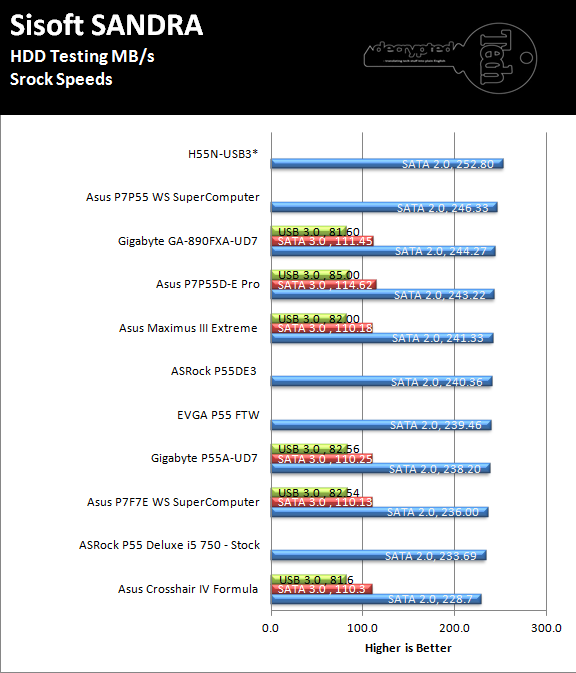 |
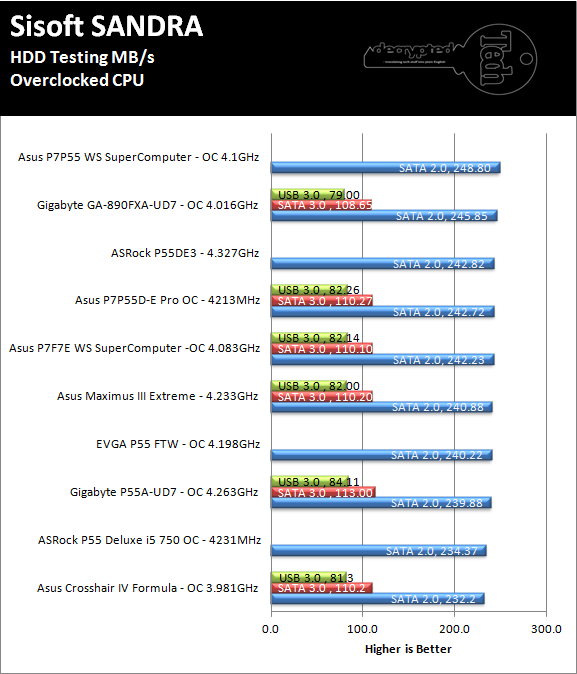 |
The HDD performance on the 890FXA-UD7 is very good, it is right up at the top of the scale here. It even tops out many of the Intel ICH10R controllers which are usually very fast.
 |
 |
 |
 |
Everest confirms our findings from Sandra and backs up the fact that you can expect some excellent performance in terms of drive speed. This could balance out the memory performance issues that we saw above and allow us to still get some good scores in our testing suite.
Power -
Power efficiency is another of those misnomers that we get caught up in. We hear about idle states and power gates. But what does that mean to you and I? On the surface having power management that reduces idle power sounds great and can be a benefit to someone that leaves their system on for long periods of time (and inactive) but how a system handles power under load and the delta between the two states is often more important than the idle power usage numbers. We use only P3 Kill A Watt instruments for measuring power.
 |
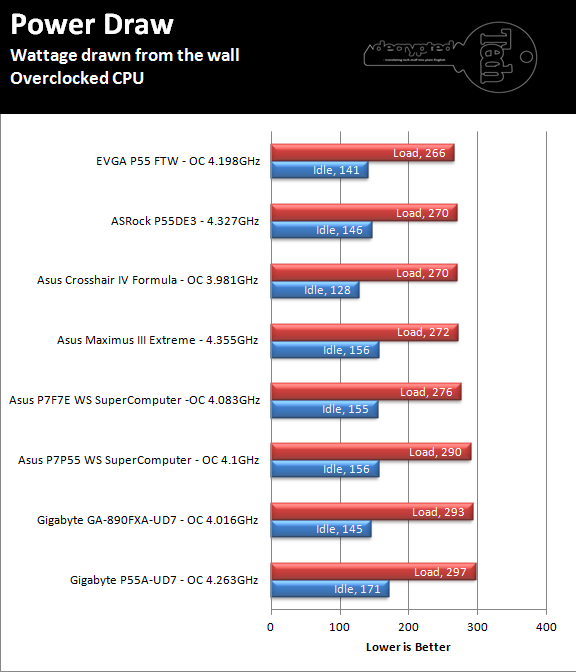 |
The 890FXA draws quite a bit of power when you make it work for you. It is not so bad at idle, but then again what a product does while idle is not as important as how well it delivers power under pressure. The dramatic delta here is concerning but it is not too far out of the ordinary. Interestingly enough when we overclock the CPU the 890FXA-UD7 does not draw much more power than it did at stock speeds.
Cooling (Board Level)
Board level cooling is an important factor in product performance and longevity. Components like the chipset, VRM modules and even capacitors need to be kept relatively cool to prevent failure. As these parts are made of silicon, they have a thermal breakdown threshold; or melting point. At that temperature the actual transistors built into chip will begin to deform and break down. Granted, the threshold is often very high, but you still need to make sure that components stay away from this level of heat for longer product life.
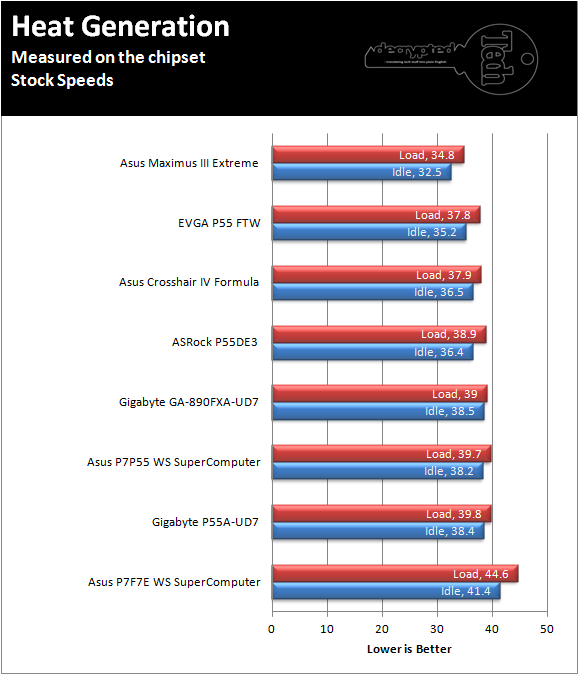 |
 |
Conversely the cooling on the 890FXA-UD7 was quite good. It also had one of the lowest deltas between idle and load out of all the boards we have tested in this group. This is good as it reduced wear on the components which provides for longer product life and also reduces wear on the rest of the system.
Audio -
Audio is highly subjective. What we find pleasing may sound “off” to you. That is always going to the problem with testing audio; results will vary too widely depending on the tastes of the listener. However, there are ways of measuring the audio output with an objective ear. There is also the issue of audio causing performance issues in gaming and video playback. The reason this is a potential source of concern is that all onboard audio CODECs (Compression/Decompression) are CPU controlled. This means that while the audio chip controls the audio levels and effects of the audio the actual work is done on the CPU. Usually this will not be a problem with today’s powerful CPUs. Even the lower and consumer level products can handle high-end audio these days. But again there is the chance that a bad design or software will hinder your system and performance. On the other side the limits of board space, cost, etc will also prevent the level of audio quality you can get from an add-in board. We test all audio parts with three media types, Movie (DVD), MP3 Music, and Gaming. These are pushed to our Tec On model 55 Tube Amp to see if we can detect any signal issues in the reproduction.
The audio on the 890FXA was acceptable; it was nothing out of the ordinary for a high-end motherboard (powered by a Realtek ALC889 audio CODEC). If you are looking for high-end audio I would recommend getting an add-in board. Of course this does not take away from the boards overall quality, like I said the audio is acceptable, you can get good gaming sounds from it and for most music playback it is more than enough. It is just not going to win any awards.
Networking -
This one is something that is a requirement anymore. If you have a computer, the chances are good (like 99%) that you are also connected to high-speed internet. With this you need a good and solid LAN chip to make sure that your data flows properly out and back.
The networking on the 890FXA is powered by a pair of Realtek 8111D GBe LAN chips these have support for direct teaming and can be set in a number of configurations. One of the most popular is simply to combine them to double your bandwidth. This is a great feature if you are using the 890FXA for a media server, or are at a LAN party that supports teamed networking. However for most home networks it will be of little use. Still it is a nice touch.
Section II - Performance Tests, Synthetic
In this section of testing we cover the synthetics. These are tests that run a scripted sequence of internal APIs or that use another installed application to perform a series of scripted events. They are great in that they can provide reproducible results across various platforms. On the down side, synthetic tests can be fooled with driver tweaks and optimizations. In some cases it is necessary to rename the .exe file to something generic to discover if this is the case. In any event when this is needed (when a test shows a drastic difference in performance over the renamed exe) we will note this and show both results for comparison.
PCMark Vantage -
PCMark Vantage is a suite of tests designed to test the power of your computer. It runs task that range from productivity to gaming (DX9 only). It is a great test to identify potential problem areas with general performance on a system. It can also show how well a single component can increase or decrease system-wide performance. We run both the x86 and x64 PCMark Suites for testing.
 |
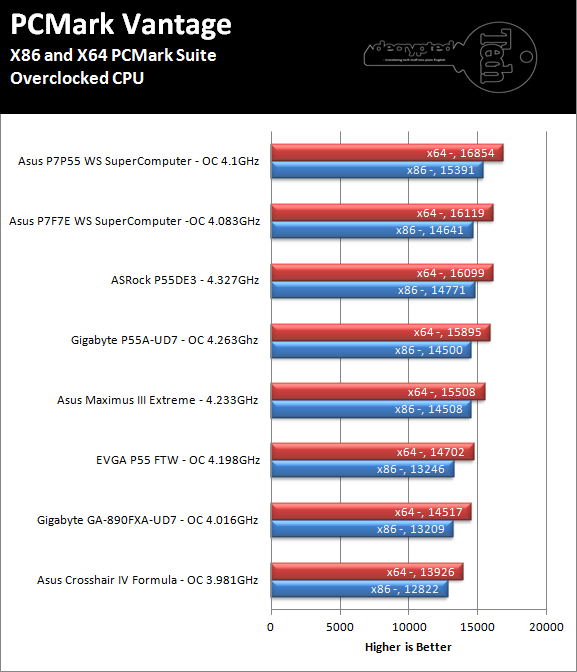 |
The 890FXA-UD7 does not do terribly well at PCMark Vantage. This is possibly a result of the poor memory performance but could also be due to an issue with the way PCMark handles six CPU cores. Even overclocked with better memory performance we see lower than expected numbers here, at least when compared to P55 based motherboards. It does manage to outperform the Asus Crosshair IV, but only when overclocked.
3DMark Vantage -
3DMark Vantage is the other FutureMark test that we run on our motherboards. This test simulates the typical tasks that a GPU (and system) would have to perform to provide you with a good gaming experience. It is based on the DX9 and DX10 engines but can only be installed on Windows Vista or later.
The suite of tests covers DX9 rendering, DX10 rendering, AI computations and PhysX. The problem with the PhysX calculations is that nVidia owns that technology. This gives them an upper hand in the test runs, for this reason we will always run 3DMark Vantage with GPU PhysX enabled and disabled when we use an nVidia GPU in our testing. As we currently use an HD 5870 this will not be an issue for now.
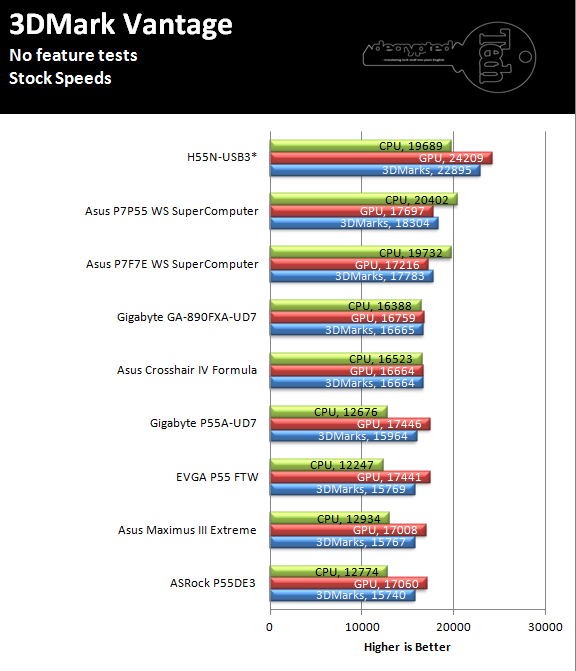 |
 |
For our 3DMark Vantage testing we find that the 890FXA-UD7 does not do too bad. It manages to keep ahead of most of the competition but lags behind the systems running either the Xeon or the 875K (understandably). It looks like we might be able to expect some good gaming performance from the 890FXA-UD7, but of course no synthetic test can tell the whole story.
HyperPi 0.99b -
HyperPi is a front end application that allows you to easily run multiple instances of the SuperPi application. SuperPi, for those that are not familiar with it, is an application that measures the time it takes to calculate the number Pi out to as many as 32 million places. This calculation is then checked and run multiple times (up to 24 for a 32M run). This test stresses the CPU, Memory and HDD as data is handed off between the three. If there is a weak link, HyperPi will show it. For our testing we run the 32M test on as many cores (and threads) as the CPU has available. The slowest CPU time is then recorded.
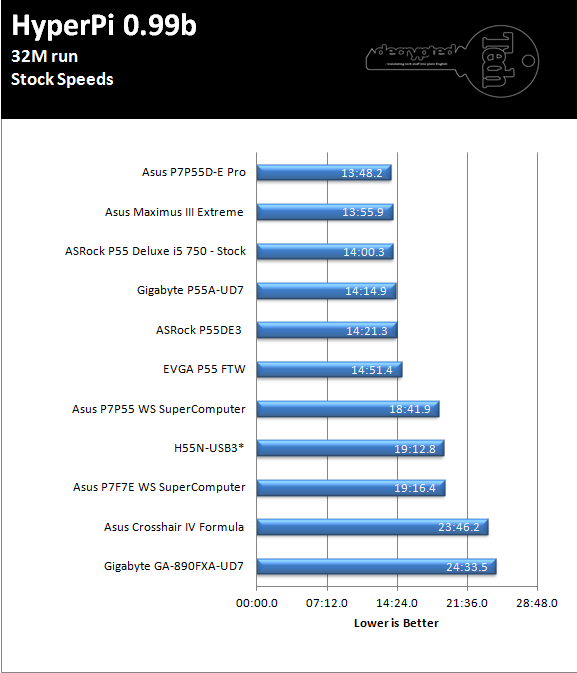 |
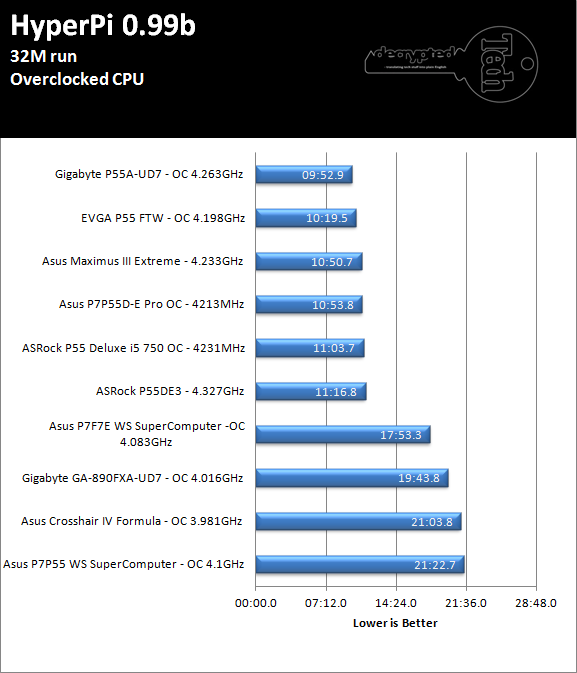 |
The HyperPi scores we see here are a direct reflection of the memory performance we saw above. At stock speeds the slower RAM performance prevents the CPU from computing PI I faster. When we pushed the CPU speed (and also the memory speeds) we see these numbers jump disproportionately to the increase in clock speed. While the slower stock speeds are a little troubling it is comforting to know that by tweaking the memory (speed, CAS etc.) we know that we can improve on the somewhat.
Cinebench R11.5 -
Cinenbench R11.5 is the 11th release of Moxon’s rendering test. This test is based off of the Cinema 4D engine, which is one of the industry standard tools for digital animation. It is a powerful product with many different modules that can be “plugged” into it to increase its effectiveness. With Cinebench you get to see how your computer would do using this application. There are two tests; one tests the CPU’s ability to render an image across multiple cores or threads. The other tests your systems ability to handle OpenGL based rendering.
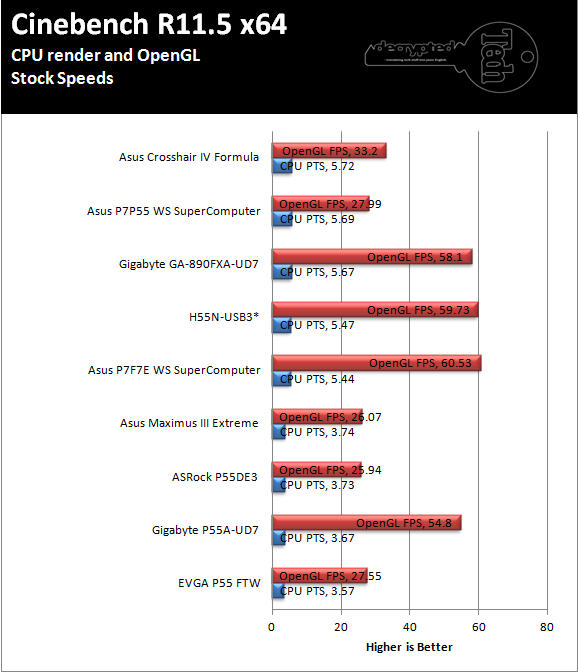 |
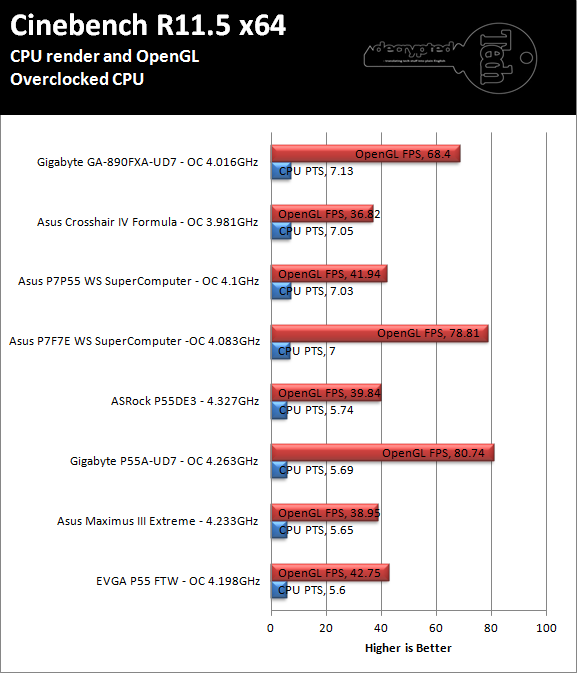 |
The 890FXA-UD7 with our Phenom II X6 1090T does excellent at Cinebench rendering. This is most likely due to the small segments the render has been broken up into. But, no matter the cause it is good to know that you can use the Gigabyte 890FXA-UD7 for this type of workstation application.
Section III - Performance Tests, Real-World
Here we have two tests that are designed to put the performance of the motherboard and its subsystems to the test. Both require good CPU, Memory, HDD and even to a lesser extent audio and network performance. The two tests we chose were Lightwave 3D 9.6 and AutoGK 2.55. We will be adding at least one more real-world test to this battery in the near future, but for now these two cover quite a bit.
Lightwave 3D 9.6 x64 -
Lightwave is another industry standard application for 3D animation and rendering. It has a large tool base and the rendering engine is highly threaded (when using the right render model). This application is also capable of expanding to 4k resolutions as well as ray tracing for rending the light sources. For our testing we use frame 470 of the Pinball scene found in the LW 9 Content folder. This uses the newer perspective camera that is better suited to a multi-CPU/Core environment. This camera style also uses ray tracing and a much improved anti-aliasing method. Settings are shown below in the attached screen shot. Of course these are single frame renders and they are not a complete picture; for that you have to take into account the number of frames an average project would have. In a typical 30 second commercial you will have around 840 to 960 frames (at 28 – 32 FPS) this means that you have to multiply the time of a single frame by that number just to get a vague idea of how long that 30 seconds would take. This is because each frame will have a different render time based on complexity.
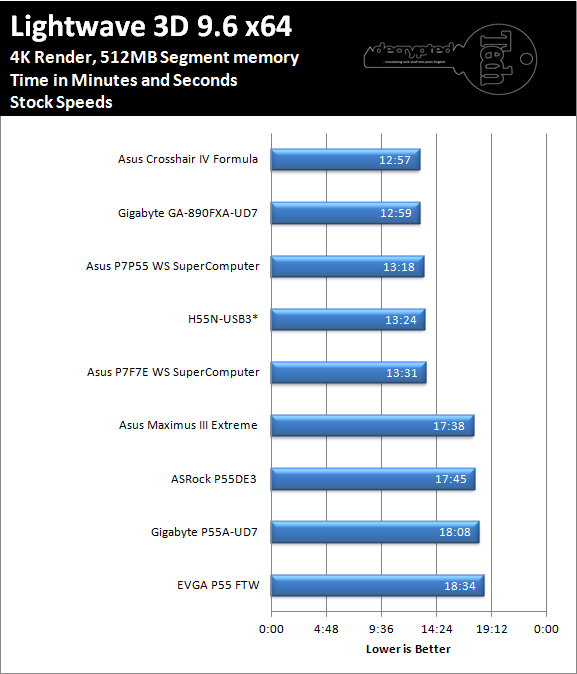 |
 |
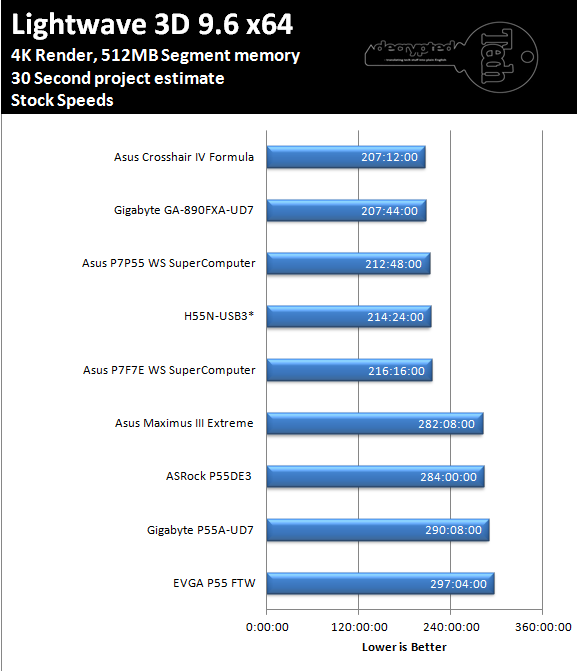 |
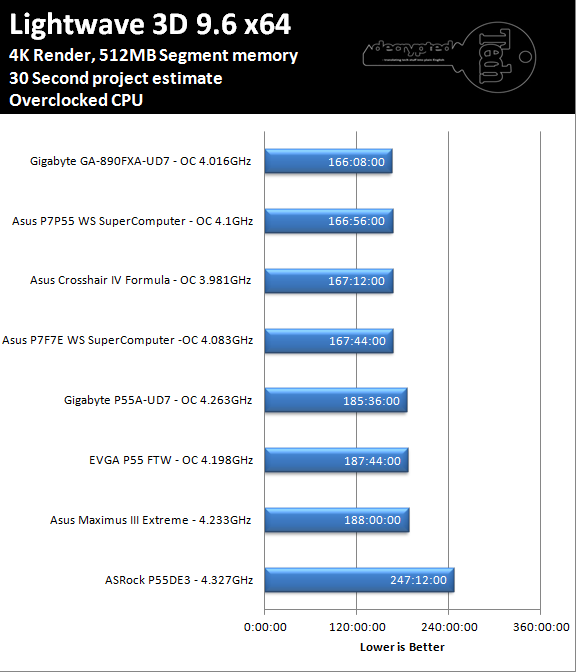 |
Well now, looks like the 890FXA-UD7 has some spine. It manages some very good numbers at Lightwave rendering. Even looking at the estimated project times we find that it is a very capable board. If we could speed up the HDD performance a little and tweak the RAM then this board would be excellent for someone building a workstation on a budget.
AutoGK 2.55 Transcoding -
AutoGK is a transcoding software that is really multiple parts combined to make an easy to use whole. It combines, items like FDD Show, Xvid encoder, Virtual Dub and others for use in converting one media format to another (usually Xvid AVI). It will not transcode copy protected DVDs or Bluray discs yet (you still need a decrypter for that). But it does an excellent job on everything else. For our testing we use a 2 hour movie that has been placed onto a standard definition DVD for playback; we then transcode this DVD to a 100% quality AVI with the original audio intact. This puts a strain on the CPU, Memory, HDD and the attached DVD ROM drive.
 |
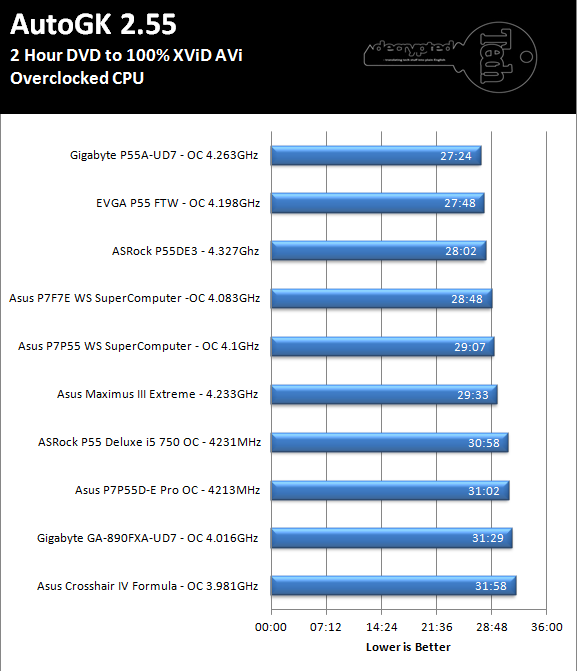 |
The 890FXA falls into line in the middle of the pack when it comes to transcoding; at least at our stock testing run. Looking at the numbers for the overclocked run it falls behind quite a bit. But that is mostly due to the lack of good memory performance even with increased memory speed from being overclocked. HDD performance also shows up in this one. The two combine to slow the 890FXA down.
Section IV Performance – Gaming
Gaming as a test of motherboard performance is sort of a joke these days. The big player in the gaming arena is the GPU. Everyone but a few hardcore PR teams know this. However, it is important to run at least a few (one from each current DX version) to see if there are any issues with the combination of components on a motherboard. These are items like Audio lag, memory lag and of course problems with the PCIe lanes and signal traces. If there are issues in design, drivers or BIOS then you can have odd gaming performance. So without much more preamble let’s dive into the three games we currently use; Call of Duty Modern Warfare 2 for DX9 FarCry 2 for DX10 and Battlefield Bad Company 2 for DX11.
Call of Duty Modern Warfare 2 DX9 -
This is an excellent but short game that put you right into the action from the beginning and does not let up the pressure until the very end. The graphics are a little better; most notably the night and thermal imaging have been improved. The AI is still the typical COD “bar fight” style AI, with maybe a tad more finesse. All in all it is not a bad game to play and a decent one to use for testing. Our testing run starts at the bridge and ends after you clear the school in the first level of the game. Settings are shown below as are the performance numbers.
 |
 |
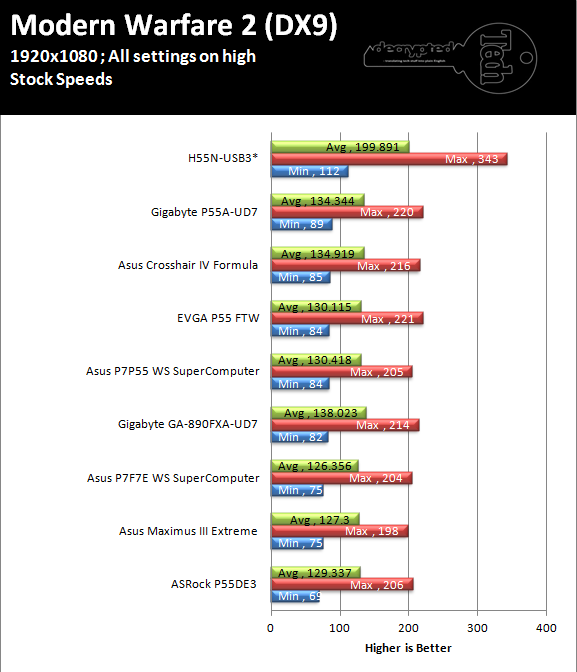 |
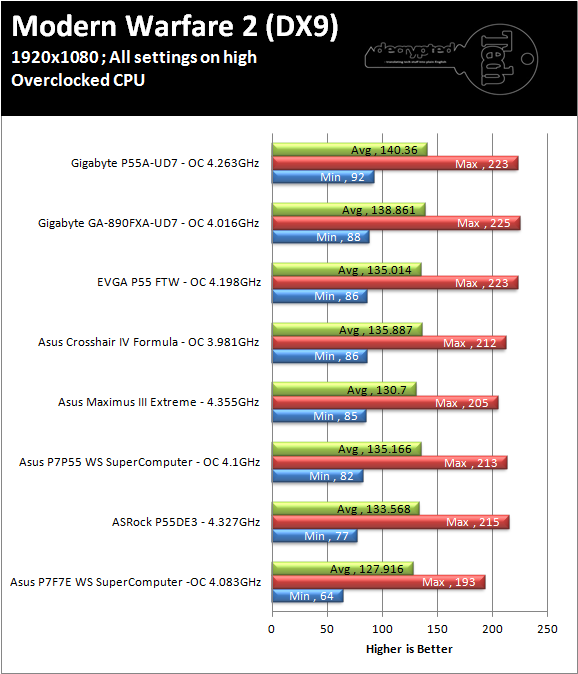 |
Gigabyte’s 890FXA-UD7 falls into place around the middle of the pack for Modern Warfare 2. It is 7 FPS behind the leading system (that used an HD 5870).Still at these speeds it is doubtful you would know the difference between any of the boards except the H55N-USB running with the HD 5970.
FarCry2 DX10 -
Although not one of my favorite games this tedious game does have some good graphics. The large sandbox style of the game lends to mission based play. The only problem is that the AI is rather low grade. Still the more CPU power the more the bad guys try to do. Over all the game was a little bit of a disappointment to play, but still not a bad DX10 representation. Our testing run starts right after you get your first mission to clean out the safe-house and ends after the hostage rescue. Settings and performance numbers are shown below.
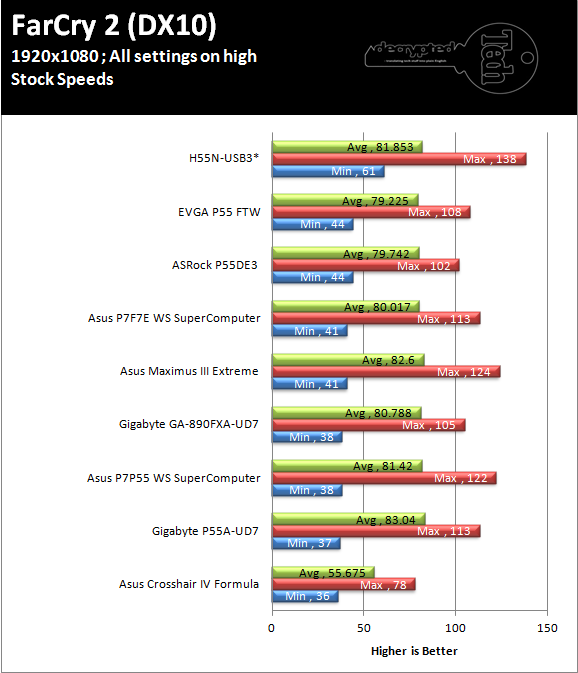 |
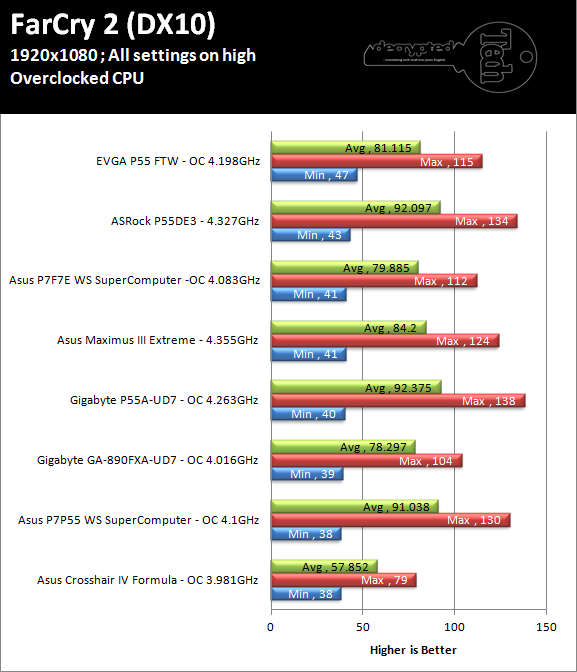 |
Again we find the 890FXA-UD7 in the middle as far as gaming goes. This time it is only behind the leading HD5870 by 6 FPS, but is ahead of this same board for average FPS. In reality any of these products would make a good gaming platform for FarCry 2.
Battlefield Bad Company2 DX11 –
I have liked many of the Battlefield games. They usually tend to be fast paced and fun. With Battlefield Bad Company 2 you do get some of that, but there is something about the graphics and the movement that just does not sit right. The AI is a less sophisticated form of the bar fight AI, but it gets the job done. Still, the game is good for testing as it can put a strain on the components of the board. Out testing run is the entire first level, from beginning to end. Settings are shown below along with the raw numbers.
 |
 |
For Bad Company 2 we see another middle of the road performance from the 890FXA-UD7. Nothing much to talk about here; it will give you an acceptable gaming experience if Bad Company 2 is your thing.
Gaming wrap-up -
What can I say about the gaming performance numbers here that I have not said before? The performance numbers here were very close. In most cases you would never be able to tell them apart if they were side-by-side. The Gigabyte 890FXA-UD7 will work for you as a good gaming platform plus it has room for expansion with the option for Quad Crossfire. The audio experience in-game was acceptable but again would not win you any audio excellence awards. The Dual Lan with teaming can be a plus if you are gaming over a LAN setup that supports teaming (Especially over 802.3ad LACP).
Value -
Value is another very subjective topic. What is expensive to some might be a deal to others. You can look at this topic in multiple ways. One is raw price and the other is what you get for the money. Each is accurate and both are correct ways to look at price/value. We tend to look at features, performance and real-property when we discuss value. However, we also take into account the raw cash cost of the item.
$245 is about what you can expect to pay if you are looking into the Gigabyte 890FXA-UD7. This is about $15 more than its nearest competitor. Of course with the 890FXA you get the option for Quad Crossfire at x8 while most other boards in this range will only give you three-way crossfire. That all on its own should be worth the extra $15. Of course there are other items like the extra cooling options (water and extended passive air Via the Silent Pipe II) that will add to the value of this board. It really does balance out with some features on the 890FXA-UD7 helping to make the higher price tag worth the stretch if you are in the market for an AMD AM3 motherboard.
Conclusion -
I like Gigabyte’s 890FXA-UD7, it does pack quite a bit into a fairly clean package. I can see this board as relatively inexpensive base for a workstation/gaming rig. With 8GB of DDR3 2000 and a pair of HD 5870s plus a Phenom II X6 1090T this would be quite the station for 3D Animation along with great gaming potential. I would have to recommend getting an add-in audio card though to complete the set as the existing Realtek, while nice, just does not match up to my tastes in audio. In terms of overclocking I had some minor success with overclocking, I think if I play around with this board more I might see what I can get from a lower clocked CPU (as well as trying out the auto unlocker utility). I have to say that while I was tinkering around with the 890FXA-UD7 I did not even think about the On/Off Charge. I know that Gigabyte sees this as a major feature, but to be honest it is not one that most consumers (especially enthusiasts) are going to go for. Still there is plenty to like about the 890FXA if you are looking into getting an AMD CPU. It is one of the better boards out there and with its extra cooling is one that will be sure to last you a while. As for the small performance anomalies we saw, I have a feeling that mush of this will be addressed in BIOS updates as Gigabyte has been improving in their time to market with updates and fixes for their products.
To wrap things up; I think that Gigabyte’s new push back into the enthusiast component market (especially motherboards) is in full swing. They are quickly learning what works and what does not. The 890FXA-UD7 is an example of what works. We hope to play around with this board more in the next month or so to see what it can do under different CPU, and GPUs. For now I will say that if you are looking into an AMD AM3 CPU then you will want to take a long hard look at the 890FXA-UD7.




